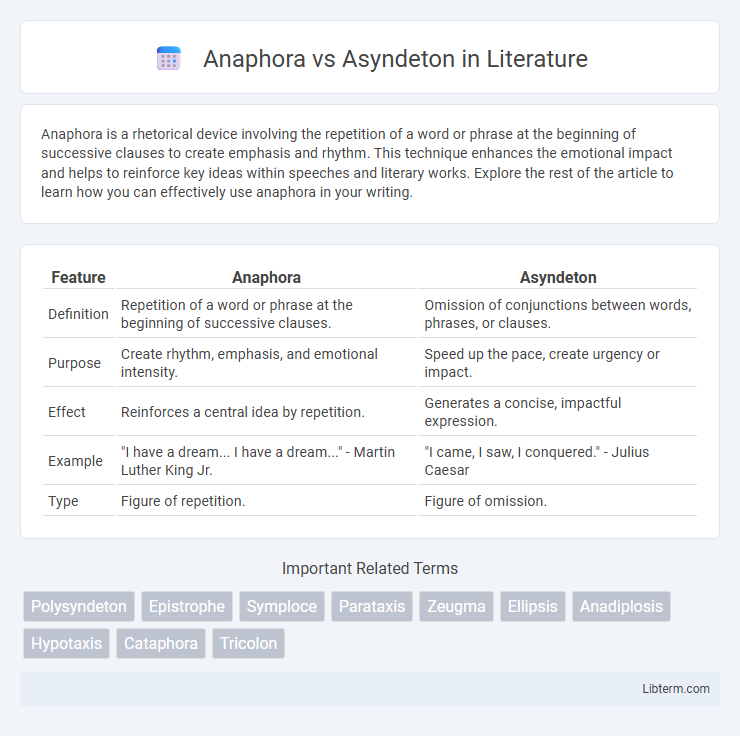Anaphora is a rhetorical device involving the repetition of a word or phrase at the beginning of successive clauses to create emphasis and rhythm. This technique enhances the emotional impact and helps to reinforce key ideas within speeches and literary works. Explore the rest of the article to learn how you can effectively use anaphora in your writing.
Table of Comparison
| Feature | Anaphora | Asyndeton |
|---|---|---|
| Definition | Repetition of a word or phrase at the beginning of successive clauses. | Omission of conjunctions between words, phrases, or clauses. |
| Purpose | Create rhythm, emphasis, and emotional intensity. | Speed up the pace, create urgency or impact. |
| Effect | Reinforces a central idea by repetition. | Generates a concise, impactful expression. |
| Example | "I have a dream... I have a dream..." - Martin Luther King Jr. | "I came, I saw, I conquered." - Julius Caesar |
| Type | Figure of repetition. | Figure of omission. |
Introduction to Anaphora and Asyndeton
Anaphora is a rhetorical device that involves the deliberate repetition of a word or phrase at the beginning of successive clauses or sentences, enhancing emphasis and rhythm. Asyndeton is a stylistic choice characterized by the omission of conjunctions between related clauses, creating a concise and impactful expression. Both techniques serve to heighten emotional effect and persuasion in speech or writing through distinct structural approaches.
Definitions: What is Anaphora?
Anaphora is a rhetorical device characterized by the deliberate repetition of a word or phrase at the beginning of successive clauses or sentences to create emphasis and rhythm. This technique enhances the emotional impact and coherence of speech or writing by reinforcing key ideas. Anaphora contrasts with asyndeton, which involves omitting conjunctions to achieve a concise and dramatic effect.
Definitions: What is Asyndeton?
Asyndeton is a rhetorical device characterized by the deliberate omission of conjunctions between words, phrases, or clauses to create a concise and impactful expression. By removing conjunctions like "and" or "but," asyndeton accelerates the rhythm and emphasizes the listed elements equally. This technique contrasts with anaphora, which involves the repetition of a word or phrase at the beginning of successive clauses to enhance emphasis and cohesion.
Historical Origins and Literary Roots
Anaphora traces its historical origins to Ancient Greek and Latin rhetoric, where it was employed by orators like Cicero to emphasize key ideas through deliberate repetition at the beginning of successive clauses. Asyndeton, rooted in classical literature, appears prominently in Greek tragedy and Roman epic poetry, intentionally omitting conjunctions to create a rapid, impactful rhythm exemplified in works by Homer and Julius Caesar's speeches. Both devices have deep literary roots serving distinct rhetorical purposes: anaphora builds momentum and emotional resonance, while asyndeton enhances urgency and intensity in narrative and persuasive texts.
Structural Differences Between Anaphora and Asyndeton
Anaphora features the deliberate repetition of a word or phrase at the beginning of consecutive clauses, enhancing rhythm and emphasis in a text. Asyndeton omits conjunctions between words, phrases, or clauses, creating a concise and rapid flow that intensifies the impact. Structurally, anaphora relies on repetition for effect, whereas asyndeton depends on the absence of connectors to produce a sense of speed and urgency.
Effects on Rhetoric and Tone
Anaphora enhances rhetoric by creating rhythm and emphasis through the repetition of words or phrases at the beginning of successive clauses, intensifying the emotional impact and reinforcing key themes. Asyndeton accelerates the pace and adds urgency by deliberately omitting conjunctions, producing a concise and dramatic tone that highlights the interconnectedness of ideas. Both devices manipulate sentence structure to engage audiences, but anaphora cultivates a solemn or passionate tone, while asyndeton fosters a brisk, forceful delivery.
Prominent Literary Examples of Anaphora
Prominent literary examples of anaphora include Martin Luther King Jr.'s "I Have a Dream" speech, where the repeated phrase "I have a dream" emphasizes his vision of racial equality. Charles Dickens' "A Tale of Two Cities" famously employs anaphora in the opening lines: "It was the best of times, it was the worst of times," enhancing the contrast through repetition. William Blake's poem "The Tyger" uses anaphora with the repeated phrase "Tyger Tyger, burning bright," intensifying the focus on the mythical creature's fiery image.
Notable Uses of Asyndeton in Literature
Asyndeton is a rhetorical device characterized by the deliberate omission of conjunctions, creating a concise and impactful effect in literature. Notable uses of asyndeton are found in Julius Caesar by Shakespeare, where the famous line "I came, I saw, I conquered" exemplifies its power to convey swift and decisive action. This technique enhances rhythm and emphasizes urgency, making it a favored stylistic choice in speeches and literary works to produce memorable and persuasive expressions.
Choosing Between Anaphora and Asyndeton
Choosing between anaphora and asyndeton depends on the desired rhetorical effect and sentence rhythm. Anaphora emphasizes a repeated phrase at the beginning of successive clauses to create cohesion and reinforce a key idea, ideal for persuasive or poetic contexts. Asyndeton omits conjunctions between words or phrases to produce a rapid, impactful rhythm, enhancing urgency or dramatic effect in speech and writing.
Conclusion: Impact on Writing and Communication
Anaphora enhances writing by creating rhythm, emphasis, and emotional resonance through the deliberate repetition of words or phrases at the beginning of successive sentences. Asyndeton accelerates pacing and generates urgency or intensity by omitting conjunctions, resulting in concise and dynamic expressions. Understanding the distinct effects of anaphora and asyndeton allows writers to strategically influence tone and reader engagement, improving overall communication impact.
Anaphora Infographic

 libterm.com
libterm.com